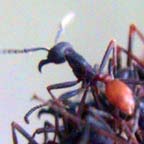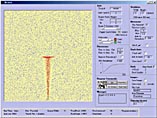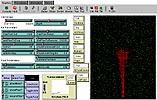
Modeling Army Ants
Introduction
Modeling work
Data Collection
Download Models
References

Introduction:
Mathematical and computer models allow researchers to manipulate systems and ask questions in ways that would be difficult or impossible to do in the field. Building a model requires you to create a precise description of the processes that are going on in the system which in turn helps you to realize very quickly what you do and don't know about a system. My ongoing research is focused on building an individual-based model of swarming behavior in the army ant Eciton burchelli.
Nearly 70 years of field work on Eciton has greatly advanced our understanding of the life-history and biology of army ants (Schneirla, 1970, Franks, 1980, Gotwald, 1995, Rettenmeyer, 1963). But no one has yet quantitatively measured the behavioral rules through which Eciton burchelli army ants organize their raiding behavior.
Only
two individual-based models of army ant swarm behavior have been created
(Deneubourg
et al., 1989; Sole, et al. 2000). Both of these models were
generated to examine emergent patterns in army ant swarms and as such
only incorporated very basic army ant biology. The
Deneubourg et al. (1989) Sole demonstrated that raiding patterns
which were visually similar to characteristic swarm patterns of existing
army ant species, could be generated through variations in resource distribution,
without changes to the behavioral parameter values. These results suggest
that differing patterns of prey distribution in the wild may play an important
role in generating species-specific differences in raiding patterns. Sole
et al. (2000) re-analyzed the Deneubourg et al. model using
a simplified genetic algorithm approach to find optimal parameter values
which maximized fitness under different food distributions. Their work
also indicated that resource distribution may strongly influence raiding
patterns, but their results yielded very different parameter values from
those chosen by Deneubourg et al. (more
information).
Field tests by Franks et al. (1991) had moderate success modifying E. burchelli foraging patterns in the field by changing resource distribution. However, other than these experiments, the Deneubourg et al. model results have only been qualitatively correlated with real army ant behavior. Army ant foraging behavior in the field has not yet been described in enough quantitative detail to permit rigorous testing of model results.
To
examine the behavioral rules involved in the organization of E. burchelli
swarms, I am creating a detailed individual-based computer simulation
of swarm behavior based on parameters determined through my field work
and from the literature. Predictions of the model will be tested in the
field to verify the accuracy of the model and the modeling work will inform
and shape the direction of my field work and allow me to investigate questions
that are not easily addressed in the field. (more
information)
The Model:
In
the Spring of 2002 I created an initial model reproducing the work of
Deneubourg et al. (1989) and Solé et al. (2000).
I
am now extending the model to include more realistic descriptions of army
ant behavior. Data is currently being collected on ant search behavior,
turn-angle, velocity and ant-density from digital video of swarms taken
in the field at
Corcovado, Costa Rica.
Data I generate through video analysis will be used to develop a more
realistic ant movement algorithm which integrates the effects on turning
behavior of both pheromone and density. The model will also include improved
spatial and temporal scales and incorporate resource distribution and
capture success data from my field work and from the literature (Franks,
1985, Franks, 1982, Franks and Bossert, 1983, Otis
et al. 1986, Rettenmeyer,
1963, Rettenmeyer
et al., 1983).
Although the Solé et al. model (2000) contained a measure
of fitness (number of prey items per ant per unit time), actual measurements
of energy use in army ants have been made (Bartholomew et
al.,
1988, Feener et al. 1988a,b) and will be included in the new model
to permit a more accurate measurement of fitness.
The data I collected at La Selva in 2001 on swarm movement, trunk trail composition and foraging success will be used to ground-truth the model. Model results will also be compared with more qualitative descriptions of distinct swarm behaviors recorded throughout my three field seasons and in the literature. With the inclusion of energetics as a measure of fitness, it will be possible to measure rigorously the impact of variations in parameter values against foraging success and real-world data on swarm behavior.
Data Collection and Analysis:
Digital
videos of E. burchelli swarms taken in Corcovado are being analyzed using
a software system I developed that permits manual tracking of individual
ants in video clips and the measurement of density.
Density
and pheromone concentration: The head and abdomen positions of every
ant in a given frame are being recorded for every 100th frame in each
video clip. This enables measurement of the distribution of size-classes
and density of ants, and their angle relative to each other and to other
ants that have passed through that area. Pheromone is also being measured
by assuming that number of ants passing a given point provides a reasonable
metric for pheromone concentration in that area.
Ant trajectories: At standardized time-points in each clip, a representative selection of individual ants are being tracked as long as they are present in the area videotaped. From these data, average turn angle and velocity can be measured. The effects of density and pheromone concentration on turn angle and velocity can then be calculated.
Download Models:
I initially worked in the java-based programming language NetLogo. NetLogo is an agent-based modeling language developed by the Center for Connected Learning and Computer-Based Modeling at Northwestern University. It is very easy to learn and is an ideal language for quickly developing basic simulations. If you are new to modeling and want to find a program that allows you quickly turn your ideas or questions into models, I highly recommend downloading NetLogo and checking it out (info below).
After creating the model in NetLogo, I switched to Visual Basic because NetLogo was not able to provide the scale (i.e. > 5,000 ants on a 100,000 millimeter grid) and level of control I needed over the model.
Download AntSim in Visual Basic:
Because VB is a windows-based program, the model will only runs on Windows-based machines. It was tested and developed in Windows 2000 but it should run fine under other Windows operating systems.
|
click to download .zip file (6.5 mb)
|
|
Note, if you have any problems installing or running this model please email me. I'm still figuring out the Installer set-up in VB and would appreciate feedback on it's effectiveness. Thanks! |
The model below was created in the program NetLogo, an agent-based modeling program written in Java. Use the link below to download the model and NetLogo program and run it from your computer.
For instructions on how to run the model, click on the 'Information' tab when the program is running.
The model has been tested online in Windows under IE5.5 and Netscape 6. It does not appear to run on Unix based machines. NetLogo should run on Macs as well, see the Netlogo Website for details
Please email me with any questions or comments you might have. Have Fun!
|
||||||||||||
References:
Bartholomew,
G.A., J.R.B. Lighton, and D.H. Feener, Jr. 1988. Energetics
of trail-running, load carriage, and emigration in the column-raiding
army ant eciton hamatum. Physiol Zool. 61: p. 57-68.
Deneubourg,
J. L., Goss, S., Franks, N., & Pasteels, J. M. (1989). The
blind leading the blind: modeling chemically mediated army ant raid patterns.
J. Insect Behav., 2, 719-725.
Feener, D.H., Jr., J.R.B. Lighton, and G.A. Bartholomew. 1988a.
Curvilinear
allometry, energetics and foraging ecology: A comparison of leaf-cutting
ants and army ants. Functional Ecology. 2: p. 509-520.
Feener, D.H., Jr., J.R.B. Lighton, and G.A. Bartholomew. 1988b.
Energetic
costs of foraging: A comparison of leaf-cutting ants and army ants (hymenoptera:
Formicidae). Proceedings of the 18th International Congress of Entomology,
p. 233
Franks, N. R. 1980. The evolutionary ecology of the army ant Eciton
burchelli on Barros Colorado Island, Panama. Ph.D. dissert., The University
of Leeds, Leeds, England.
Franks, N.R. 1982. Social insects in the aftermath of swarm raids
of the army ant eciton burchelli [ethology, escape and foraging behaviors],
in The biology of social insects: Proceedings, ninth congress, international
union for the study of social insects, boulder, colorado, august 1982,
H.E. Evans, Editor. Westview Press: Boulder. p. 275-279.
Franks, N.R.. 1985. Reproduction, foraging efficiency and worker
polymorphism in army ants, in Experimental behavioral ecology and sociobiology:
In memoriam karl von frisch,1886-1982, M. Lindauer, Editor. Sinauer Associates:
Sunderland, Mass. p. 91-107.
Franks, N.R. and W.H. Bossert. 1983. The influence of swarm
raiding army ants on the patchiness and diversity of a tropical leaf litter
ant community, in Tropical rain forest: Ecology and management. Special
publication of the british ecological society no. 2, A.C. Chadwick, Editor.
1983, Blackwell: Oxford. xii + 498 p. p. 151-163.Franks, N. R. 1989.
Army ants: a collective intelligence. Am. Scient., 77, 139-145.
Gotwald, W. H., Jr. 1995. Army ants: the biology of social predation.
Ithaca, New York: Cornell University Press.
Hölldobler, B., & Wilson, E. O. 1990. The ants. Cambridge,
Mass.: Harvard University Press.
Otis, G.W., et al. 1986. The effect of foraging army ants
on leaf-litter arthropods. Biotropica, 1986. 18: p. 56-61.
Rettenmeyer, C. W. 1963. Behavioral studies of army ants.
Univ. Kans. Sci. Bull., 44, 281-465.
Rettenmeyer, C.W., et al. 1983. Comparative foraging by
neotropical army ants, in Social insects in the tropics. Volume 2, P.
Jaisson, Editor. Université Paris-Nord: Paris. 252 p. p. 59-73.
Schneirla, T. C. 1971. Army ants. A study in social organization.
(Edited by H. R. Topoff.). San Francisco: W. H. Freeman & Co.
Sole, R. V., Bonabeau, E., Delgado, J., Fernandez, P., & Marin,
J. 2000. Pattern formation and optimization in army ant raids. Artificial
Life, 6(3), 219-226.
Swartz, M. B. 1997. Behavioral and population ecology of the army
ant Eciton burchelli and ant-following birds. Unpublished Ph.D.
Dissertation. University of Texas, Austin.
Topoff, H. 1984. Social organization of raiding and emigrations
in army ants. Advanced Studies in Behavior 14: p. 81-126.
Watmough, J., & Edelstein-Keshet, L. (1995). A one-dimensional
model of trail propagation by army ants. J. Math. Biol., 33, 459-476.

